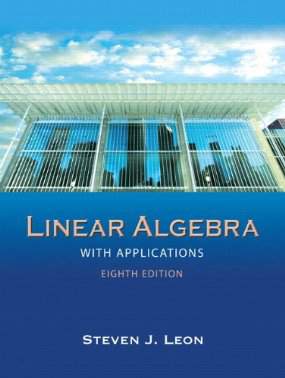Connecting...

This is a quick preview of the lesson. For full access, please Log In or Sign up.
For more information, please see full course syllabus of Linear Algebra
For more information, please see full course syllabus of Linear Algebra
Linear Algebra Properties of Matrix Operation
Lecture Description
In this video we’ll continue our discussion of the basics of matrices by diving into their unique properties of computation. Especially well shown with matrix multiplication, many properties, like the commutative property, are not applicable to matrices. The exact rules of which properties work with matrices can get confusing when trying to memorize, so it’s best to write out a sample matrix operation and move things around in the equation and solve to see if you arrive at the same answer. This is an important and tricky subject, so try your best with it and only move on when you have a really good grip on it.
Bookmark & Share
Embed
Share this knowledge with your friends!
Copy & Paste this embed code into your website’s HTML
Please ensure that your website editor is in text mode when you paste the code.(In Wordpress, the mode button is on the top right corner.)
×
Since this lesson is not free, only the preview will appear on your website.
- - Allow users to view the embedded video in full-size.
Next Lecture
Previous Lecture










































 Answer Engine
Answer Engine




1 answer
Thu Nov 17, 2016 6:14 AM
Post by Kunal Malhotra on November 16, 2016
Firstly, thank you very much. With your method of breaking down the process of thinking from educator to student I feel like I could graduate college in a year, maybe less (if it was allowed). I don't know what they pay you but they need to double it and give you a Christmas bonus. Secondly, would you or any other Educator be teaching any upper level courses in the near future, such as: 1) Financial Mathematics,
2) Real Analysis, 3) Monte Carlo Simulation 4) Stochastic 4) Fractals?
Is there anyway this can be possible?
Thanks in advance! Keep up the great work! Happy Holidays!
1 answer
Wed Dec 30, 2015 12:38 AM
Post by Hen McGibbons on December 26, 2015
OMG! at 34:50 you said abstract algebra was your favorite mathematics! but you said in the course introduction that linear algebra was your favorite! which is the true favorite?
1 answer
Thu Mar 13, 2014 7:56 PM
Post by Ikze Cho on March 13, 2014
a m by n matrix to the zero power is the identity matrix.
but what dimensions does the identity matrix have?
Thanks in advance
1 answer
Thu Nov 14, 2013 4:55 PM
Post by matatio manoah on November 13, 2013
how did you multiply the first part
0 answers
Post by Real Schiran on March 1, 2012
Fantastic explanation , thanks pro